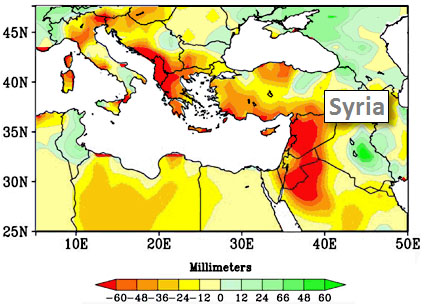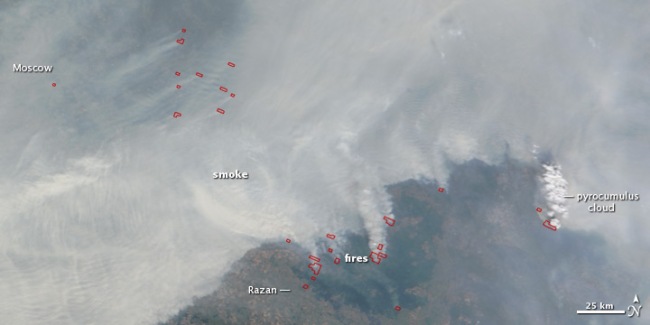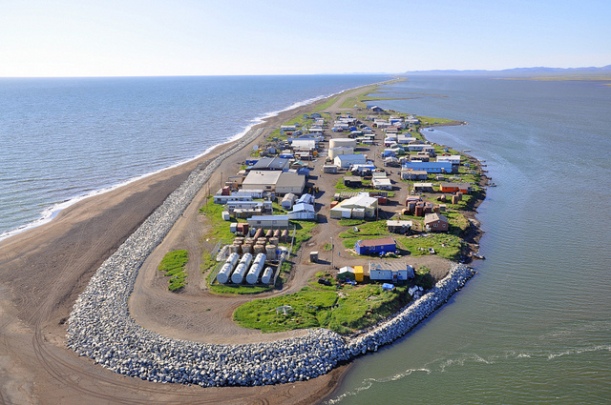“Everything
I was Dreaming of is Gone” — How Climate Change is Spurring a
Global Refugee Crisis to Rapidly Worsen
4
September, 2015
Over
the past two weeks, news of the plight of a swelling wave of refugees
fleeing to Europe has filled the mainstream media. We looked on in
horror at reports of innocent human beings fleeing destabilized
countries in the Middle East, of people suffocating while stuffed
into the backs of trucks, of drowned children washed up on the shores
of nations their families had hoped would care for them.
It’s
all a part of a growing global mass migration. A tragic dislocation
and diaspora. But this time it’s not only birds, or polar bears, or
fish, or walruses, or insects, or plants that are being forced to
move by habitat and food loss, by toxified environments or by
increasingly dangerous weather. It’s human beings too.
*
* * * *
“Everything
I was Dreaming of is Gone”
(Dead
Syrian toddler is not only a victim of conflict. He is a victim of a
destabilized climate. Video source: Here)
In
the above video we are rightfully compelled to compassion for a
drowned boy and his family. A family suffering in a country ripped
apart by conflict. A country fractured by insurgent forces that will
use any form of brutality to gain and secure power. And in this very
narrow frame we are provided with a perpetrator — ISIS — and
an-all-too innocent victim. The call for warfare against the human
monsters that make up ISIS is clear. But the conditions that created
the monster in the first place, as happens all too often with climate
change, are completely ignored.
Climate
Change as Threat Multiplier in Syria
Syria
was never a stable country. At least not so long as colonial and post
colonial powers inhibited its development as a functional state.
There was always a reason for interference in Syria’s affairs and
for a related exploitation of its resources. As the fossil fuel age
dawned, such interference became even more intense. Powerful nations
and empires wanted Syria’s oil. And when Syria’s oil was gone and
the country left suffering from the bitter after-effects of that
resource’s deleterious curse, those same powers wanted Syria to
remain both stable and weak. To remain sidelined so as not to
influence the flow of oil from nearby countries. Countries like Iraq
where the West has conducted an ongoing war since the early 1990s.
We
justified this under such international relations terms as the
realism-based ‘rational self interest of nations.’ And it was
this self interest paradigm that national and international
businesses — primarily oil companies — used to justify an ongoing
exploitation of an increasingly fractured land, its people, and of a
resource itself whose continued burning would make an ugly situation
far, far worse.
On
October 13 of 2014, US
Secretary of Defense Chuck Hagel called human-forced climate change,
through the fossil fuel based dumping of carbon into the atmosphere,
a ‘threat multiplier’ saying:
“Rising global temperatures, changing precipitation patterns, climbing sea levels and more extreme weather events will intensify the challenges of global instability, hunger, poverty, and conflict. They will likely lead to food and water shortages, pandemic disease, disputes over refugees and resources, and destruction by natural disasters in regions across the globe.”
What
he failed to mention, however, was that for Syria and ISIS it had
already happened.
The
Drought that Forge ISIS
Before
there was ISIS, there was drought. A three year long drought
beginning in 2007 and finally ending in 2010. A drought so severe and
intense that it basically wiped out Syria’s farming industry. The
farmers, mostly family farmers, were faced with a situation in which
water use was terribly constrained (due to the combined drought
severity and the short-sighted policies of the Syrian government).
Farm after farm failed. By 2011, more than 1.5 million people had
migrated from the ruined and desiccated rural farms to the cities.
Cities that, in turn, became hot-beds of unrest and insurgency.
(Map
published by NOAA in its 2011 report on Mediterranean drought during
2005 to 2010. In a related finding, Syria experienced its worst
drought on record during 2007 to 2010 resulting in the mass loss of
farmland and the displacement of 1.5 million people to urban centers.
Image source: NOAA
— Climate Change Probably A Factor in Syria’s Civil War.)
A
scientific report published in the Proceedings of the National
Academy of Sciences in
March found that Syria’s epic 2007-2010 drought had been developing
over the course of a century of warming. That the drought was both
spurred and made more severe by human forced climate change. And that
the increased intensity of drought added by human forced warming
likely pushed Syria’s rural farms past the breaking point. The
report noted:
There is evidence that the 2007−2010 drought contributed to the conflict in Syria. It was the worst drought in the instrumental record, causing widespread crop failure and a mass migration of farming families to urban centers. Century-long observed trends in precipitation, temperature, and sea-level pressure, supported by climate model results, strongly suggest that anthropogenic forcing has increased the probability of severe and persistent droughts in this region, and made the occurrence of a 3-year drought as severe as that of 2007−2010 2 to 3 times more likely than by natural variability alone. We conclude that human influences on the climate system are implicated in the current Syrian conflict.
The
drought, therefore, led to desperation, hunger, anger, and unrest. It
provided a mass of displaced persons who had lost the means to
provide for themselves and their families. It provided both the
trigger and the means for the development of what would later become
ISIS (for more on how the Syrian drought helped destabilize the
country you
can read this brief, but very informative, comic strip).
Threat multiplier indeed.
Worst
Heatwave in 130 Years Forces Russian Crop Failures, Spurs Arab Spring
As
is well known, the flood of refugees coming to European shores are
not solely Syrian. Libya, Egypt and a broad number of African and
Middle Eastern countries now face destabilizing unrest, violence, and
growing numbers of internally displaced persons seeking asylum in
other countries. It is this now endemic instability and displacement
that can be primarily linked back to two events — drought-spurred
crop failures in 2010 and the related food riots that ignited what is
now known as the Arab Spring.
For
as Syria was experiencing its worst drought in a century, the most
intense heatwave in at least 130 years was in the process of also
crippling Russia’s agriculture. This terrible heatwave spurred
fires, wrecked crops and resulted in the hothouse mass casualty
deaths of over 50,000 Russian people. It
was an unprecedented event that climate scientist Stephan Rahmstorf
identified as 80 percent more likely due to human-forced warming of
the atmosphere and oceans.
An event that put Russia, typically a major grain exporter, in such a
terrible food security situation that it was forced to halt grain
exports entirely.
(Wildfires
and pyrocumulous clouds over Russia during the great heatwave of
2010. A heatwave that killed 50,000 people and crippled Russia’s
agricultural industry. Image source: Earth
Observatory and Discovery News.)
By
2011, global food prices — spurred ever-higher by wide-ranging
droughts and extreme weather — put millions of people in the Middle
East and North Africa in a desperate situation. Food became less and
less accessible. In Egypt, the plight of a child set off mass food
riots. These food riots spread across the Middle East resulting in
the collapse of Egyptian, Syrian, and Libyan governments. Setting in
place the severe refugee situation we see today.
Climate
Change as Trigger to Europe’s Refugee Crisis
In
emerging threats terminology, given the scientific basis for climate
change’s influence on extreme weather events related to the refugee
crisis, related to the destabilization and collapse of nations, we
can identify the Syrian and Russian droughts and heatwaves as
precursor crisis influencing and trigger events. What the US
Department of Defense terms threat multipliers. Climate change, in
this instance, made the Syrian drought and the Russian heatwave
worse. These impacts in turn increased desperation, displacement, and
hunger in numerous countries spurring unrest and, in some cases,
societal collapse.
In
Syria, 1.5 million people were directly displaced as the result of a
climate change worsened drought. In the Middle East as a whole,
nations were indirectly destabilized due to a crop-destroying and
climate change worsened heatwave in Russia which set off a
wide-ranging food crisis. This destabilization, in its turn, led to
still more internally displaced persons in places like Libya and
Egypt. Many of whom eventually joined the rising flood of human
traffic to the still greener shores of Europe.
And
it is in this way that climate change is a root cause to Europe’s
refugee crisis. For without climate change we remove the extreme
weather amplifier which is a trigger to the whole growing disaster.
Refugee
Crisis is Massive, Global, and Growing
Unfortunately,
Europe, Africa, and the Middle East are not the only regions seeing
growing bodies of internally and internationally displaced persons.
This week, President
Obama in a recent visit highlighted the plight of tens of thousands
of Alaskan coastal dwellers whose 31 communities are being devoured
by an increasingly stormy and rising Arctic Ocean.
In Pakistan coastal farmers are fleeing inland as the fertile lands
in the Indus River Delta are being tainted with salt. So
far, the count of migrant climate change refugees due to farmland
loss is 150,000 Pakistanis.
But as seas continue to rise, the situation only worsens. In
Bangladesh, cities are already overcrowded with tens of thousand
fleeing a rapidly receding coastline.
And in the Pacific, low
lying island dwellers in the Maldives, Kirubati, and hundreds of
other shrinking atolls are seeking homes in far-flung countries
possessing lands well above the rising tides.
(Kivalina,
Alaska is one of 31 communities now being devoured by the Arctic
Ocean and Bering Sea due to a combination of sea level rise,
permafrost thaw, and increased wave action due to loss of sea ice.
Image source: The
Union of Concerned Scientists.)
In
total, around the world, 158
million people were displaced by extreme weather events related to
climate change since 2008.
The fires, floods, hurricanes, extreme droughts, heatwaves and other
storms are all growing worse, more violent, more likely to destroy
homes and livelihoods. And it’s due to the heat we’ve added into
the Earth’s climate system that extreme weather is now a greater
direct cause of displacement than even the terrible scourge of
warfare.
Some
of the persons driven from their homes by such worsening events are
able to eventually return to their livelihoods. But some are bereft
of necessary aid — living in regions or nations which lack the
resources to help. Such persons eventually become tent dwellers or
add to the ever-growing tide of people seeking refuge in other, more
seemingly stable, countries.
Climate
change, extreme weather, human displacement and related political
instability are thus now linked in a broad web that spans the globe.
And the situation keeps getting worse and worse. It’s a situation
that won’t change anytime soon. And one that can only be abated by
a concerted response by nations — all of which are now under threat
— to both help those people put in this terrible situation and to
stop worsening the damage through a rapid cessation of fossil fuel
based carbon emissions. Otherwise, by failing to rapidly act, by
focusing instead on broadening warfare and conflict rather than root
causes, more and more nations and regions will fall under the threat
of destabilization, mass impoverishment and collapse as this climate
change spurred crisis grows in scope, breadth and intensity.
Links:



No comments:
Post a Comment
Note: only a member of this blog may post a comment.